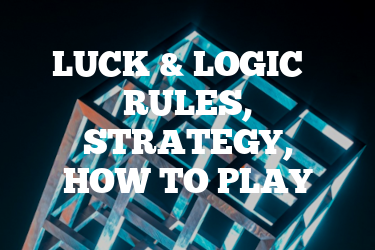A Beginner’s Guide to Winning at Luck & Logic CCG
Introduction
Luck & Logic is a collectible card game that combines strategy, logic, and a bit of luck, (may be unsurprising to you, as the name suggests). It was first released in Japan in 2016 by Bushiroad, the same company behind popular games like Cardfight!! Vanguard and Future Card Buddyfight – CCGs I’ve written guides on previously. The game got a decent reception with some interesting gameplay mechanics and was boosted in popularity by the anime series that accompanied its release.

The game is set in a world where foreign entities known as “Foreigners” pose a threat, and players, known as “Logicalists,” team up with these Foreigners to combat the menace. The game is played with a deck of cards representing various characters, tactics, and powers. Although Luck & Logic had a strong start, it’s important to note that the game is no longer in active print. However, there’s still a dedicated community, and cards are available on the secondary market.
Quick Tip for Luck & Logic
Always keep an eye on your opponent’s stock zone; it gives you a clue about their potential moves!
Rules for playing Luck & Logic
Understanding the rules is crucial to enjoying any game, and Luck & Logic is no exception. The game is played between two players, each with a deck of 50 cards. The objective is to attack your opponent and reduce their life to zero. Each player starts with six life. The game is turn-based, with each turn consisting of three phases: Draw, Main, and End.
In the Draw Phase, you draw a card. Simple, right? Next is the Main Phase, where the real action happens. Here, you can summon allies, called “Members,” and use their abilities. You can also “Level Up” your Logicalists by placing cards beneath them, which allows for stronger attacks and abilities. The Main Phase is also where you declare attacks on your opponent’s Members or directly to their life if they have no Members in the defense zone.
Combat involves comparing power levels of attacking and defending cards, with the higher power winning. If you attack your opponent’s life directly and they can’t defend, they lose one life. The End Phase is for housekeeping: resolving any end-of-turn effects and preparing for the next turn.
Card Types for Luck & Logic
There are several card types in Luck & Logic:
- Logicalist: Your main character card that can level up and lead attacks.
- Foreigner: These cards can be “tranced” with Logicalists for powerful combinations.
- Member: Allies that support your Logicalist and can attack or defend.
- Tactics: Special actions that can turn the tide of battle.
- Paradox: Cards that can alter the game’s rules temporarily.
- Gate: Your life points, which double as additional resources when lost.
Starter sets are available for beginners, which provide a balanced deck to learn the game. These sets are themed around different characters and playstyles.
How to Play Luck & Logic and Game Mechanics
Playing Luck & Logic involves understanding key game mechanics:
- Trance: Combine a Logicalist and Foreigner to create a powerful Tranceunion.
- Intercept: Use Members to defend your Logicalist or life points from attacks.
- Stock: A resource generated from attacking that’s used to activate abilities.
Setup is straightforward: each player prepares their deck, shuffles, and draws five cards. You can mulligan once, returning any number of cards to the deck and drawing that many again. Place your Gate cards in the life zone, and you’re ready to play.
Gameplay revolves around using your cards effectively during your Main Phase and defending against your opponent’s attacks during their turn. The game ends when one player’s life points are reduced to zero.
How to Win at Luck & Logic
Winning at Luck & Logic requires a mix of strategy and adaptability. As a beginner, focus on learning how different cards interact and how to manage your resources effectively. Intermediate players should start recognizing patterns in their opponents’ play and adapt their strategies accordingly. Advanced players will need to master the art of bluffing and predicting their opponent’s moves.
Understanding the meta, or the most popular decks and strategies, is also crucial. This knowledge can help you build a deck that’s not only strong but can counter what you’re likely to face.
Best Strategies for playing Luck & Logic game
To excel at Luck & Logic, you’ll want to:
- Balance your deck with a mix of Logicalists, Foreigners, Members, and Tactics.
- Learn the strengths and weaknesses of different Tranceunions.
- Keep track of your Stock to ensure you can use your abilities when needed.
- Anticipate your opponent’s moves and prepare counters.
- Manage your hand size to avoid running out of options.
Sneaky tactics might include bluffing about the cards in your hand or setting traps with Paradox cards that your opponent won’t expect.
Deck Building and Best Cards
Building a strong deck is key to success in Luck & Logic. You’ll want a good mix of card types and a clear strategy. Some players focus on aggressive decks that aim to win quickly, while others prefer control decks that aim to outlast the opponent.
Best Cards in Luck & Logic
Some of the best cards to consider for your deck include:
- Yoshichika Tsurugi: A strong Logicalist with versatile abilities.
- Athena: A powerful Foreigner that can create strong Tranceunions.
- Monolium Tactics: Tactics cards that provide excellent support and utility.
Scenarios
Good scenarios in Luck & Logic might involve having a strong board presence with multiple Members and a Tranceunion ready to attack. Bad scenarios could be facing an empty hand or being on the defensive with low life points. To turn these around, focus on building your resources and setting up for a powerful counter-attack.
Frequently Asked Questions about playing Luck & Logic game
Here are some common questions and answers:
Q: How many cards can I have in my hand?
A: There’s no upper limit, but if you have no cards in your deck at the start of your turn, you lose.
Q: Can I change my deck between games?
A: In a tournament setting, you must use the same deck throughout. Casual play is more flexible.
Q: What happens if both players reach zero life at the same time?
A: The game is a draw.
Additional Tips and Tricks
When playing Luck & Logic, always be aware of your opponent’s discard pile. It can give you valuable information about what they’ve played and what they might still have in their deck. Also, don’t underestimate the power of Paradox cards; they can completely change the flow of the game if used correctly.
Lastly, practice makes perfect. The more you play, the better you’ll understand the intricacies of the game and how to react to different situations.
External Links
If you’re interested in the cultural impact of Luck & Logic, you might want to check out the anime series that was released alongside the game. It provides a deeper understanding of the game’s world and characters. Here’s a link to the anime’s official page: Luck & Logic Anime.

A digital native around since the early days of online gaming communities around 2001. An early contributor to the cult gaming site ClanTemplates, Adam has spent years giving free gaming resources to the community. With BoardCards, Adam is most experienced and commonly writing the articles on Strategy multi-player games like Settlers of Catan and Avalon. His first introduction to board games was via Mancala, an Egyptian-origin stone game and one of the oldest known games still played worldwide. Contact me via email



